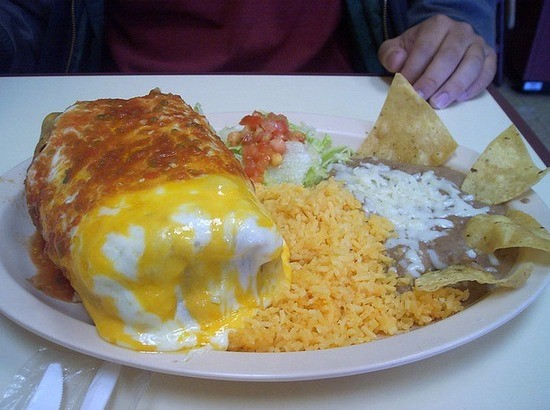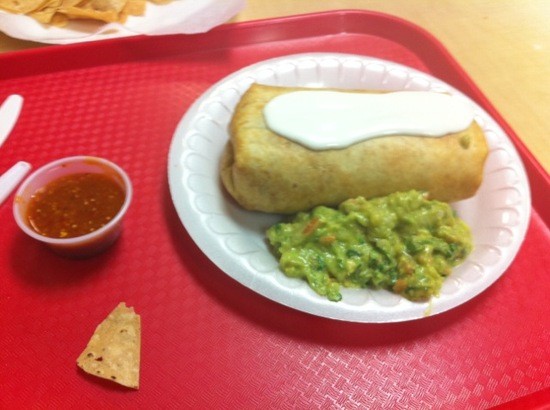
Let me start this post by admitting that the following is pure speculation. Let me also note that folk etymologies are notoriously inaccurate, that Mexican-food origin stories are frequently ludicrous, and that this mini-essay might be the most ludicrously inaccurate history of a Mexican foodstuff yet.
Yet…refry this attempt at trying to discover the origins of the chimichanga by bringing up the Chinese.
]
Next to the margarita, no Mexican food item has a more contentious creation myth than the chimichanga. Everyone agrees that it first appeared somewhere in the Arizona-Sonora borderlands, but that's about it. The two loudest claimants are the legendary Macayo's in Phoenix, which claims its owner created the chimi as a way to keep a burrito around for longer (without saying they coined the name), and El Charro Cafe in Tucson, which maintains its founder invented the crispy, wonderful burrito-child by accidentally tossing a burrito in the fryer, and–wanting to yell some derivative of chingar but noticing kids nearby–yelled “Chimichanga!” instead.
Both explanations are weak salsa. But in April, someone sent a fascinating letter to the Arizona Daily Star regarding an article they had done about the origins of the chimichanga. He claimed that his wife's Sonoran family had been eating chimichangas in deepest, darkest Sonora since the early 1900s, calling them “chivichangas” (the name that the dish still goes by in the state). And then this stupendous assertion:
A few years ago we told the el Charro [origin myth] to Professor Francisco Paz, a geology professor at the Universidad de Sonora, originally from Nogales. He said no, no — they were brought into Sonora by Chinese workers. Often Chinese men married Mexican women who tried to cook Chinese food for their husbands. Chivichanga has no linguistic roots in Spanish, and was likely as close as Mexican ears could capture the Chinese name for it.
Have Mexican food scholars been going at the origins of the chimichanga the wrong way all these years? Fact is, the word “chimichanga” has no roots in Spanish whatsoever. “Chimi” means nothing by itself; “changa” is a female monkey in Mexican Spanish, but seems superfluous here. The closest cognate in the Hispanic world is the Argentine chimichurri, itself a word with a disputed origin (more on that in a bit).
But, given the Daily Star letter, what about if we broke up “chimichanga” into syllables, then tried to find cognates in Cantonese, the language of the Chinese who settled in Sonora and Baja California in the early 20th century? Doing that unveils a possible answer that isn't as far-fetched as it originally seems.
[

The Chinese settled in Sonora by the tens of thousands in the early 1900s to work the state's mines and railroads. Northern Mexico also received an influx of Chinese-Americans who were fleeing racist gabachos (the tide would turn in the 1920s, as Chinese fled racist Mexicans, leading to the creation of the U.S. Border Patrol–true story!). To this day, you can still find Chinese restaurants in Mexicali and sprinkled across Sonora. And in Sonora and the seafood of the Gulf of California, soy sauce has become a tableside staple, along with other Chinese culinary traditions.
Nearly all of those immigrants spoke Cantonese, so I asked a Mexican friend whose wife spoke fluent Cantonese to play around with “chimichanga,” breaking it down by syllables if need be. Was there a similar-sounding word or phrase related to food, or something rolled, or something, anything? And the answer was…kind of.
First, we have to conceptualize a chimichanga as a giant eggroll. Don't laugh: in Little Saigon, Vietnamese restaurants catering to Mexicans translate goi cuon as “taquitos.” Cantonese immigrants coming to Sonora would've recognized a burrito as similar to their own rice noodle rolls, slippery and sumptuous. And they would've brought their egg rolls to Sonora–and there would've been culinary miscegenation, along with the regular miscegenation, you know?
So, following that train of thought: Per my pal's wife, Gee May is a proper name in Cantonese, and chun geen means eggroll. Gee may chun geen, then, would mean “Gee May's egg roll.” Conversely, a Gee May could easily Americanized his name (whether in the U.S. or Sonora, where there were a lot of gabachos) to “Jimmy” and sold Jimmy's chun geen–Jimmy's eggroll. Mouth it out slowly–Gee may chun geen–add in the Mexican Spanish propensity for elision, and you've got a rough approximation of chimichanga.
Don't laugh: one proposed etymology for chimichurri is that it came from “Jimmy's curry,” and used to mock British prisoners-of-war in Argentina.
Of course, China is a land of many languages and dialects, so I asked my pal for more possibilities. Broadening out to Mandarin (which a majority of Chinese immigrants in early 20th century Mexico and the United States would've understood, if not outright spoken), my pal's wife came back with zi wei, which refers to the Purple Star, also known as the Emperor Star (the North Star) in zi wei dou shou, a form of fortune-telling in China. Given the Chinese propensity to go overboard in naming dishes (chicken feet in her Chinese experience are called “Phoenix claws”–HA!), perhaps a Chinese restauranteur in Mexico sold giant eggrolls under the name zi wei chun geen–Emperor Star egg rolls, a poetic way of saying “big ass egg rolls. A Mexican or American heard this (or the alternate Gee May chun geen, or Jimmy's chun geen, tried to replicate them using burritos, and Mexicanized it to “chimichanga.”
Again: all of the above is speculation. But stranger etymologies have happened–look up the history of the dunce cap, and remember that nachos were named after an actual Ignacio. And Chinese terms for foodstuffs that are now American favorites isn't anything new–look at the history of ketchup, which started as a Chinese fish sauce, went to Malaysia, then England, then finally the United States, turning from the original kôe-chiap to the current ketchup. Any Cantonese or Mandarin speakers: feel free to rip on my kindergarten-level efforts in the comments below. Everyone else: what do YOU think?
Follow Stick a Fork In It on Twitter @ocweeklyfood or on Facebook! And don't forget to download our free Best Of App here!


This is insane. I was just looking for a restaurant that may have a Chinese chimichanga. I imagine a deep fried burrito with chow mein, jalapeños & orange chicken inside, Then drizzled with sweet & sour sauce and ragoon filling on the outside would taste pretty bomb with a side of Mexican rice. Thanks for the rabbit hole 😂
Hmm it seems like your blog ate my first comment (it was
super long) so I guess I’ll just sum it up what I wrote and say,
I’m thoroughly enjoying your blog. I too am an aspiring blog writer but I’m still new
to the whole thing. Do you have any recommendations for
rookie blog writers? I’d definitely appreciate it.
I think this is one of the so much significant information for me.
And i am satisfied studying your article. However want to
observation on some general things, The web site style is wonderful,
the articles is in point of fact excellent
: D. Good process, cheers
Sustain the exceptional job !! Lovin’ it! Compra decadron sin receta en Suiza
Hey there! I understand this is kind of off-topic but I had to ask.
Does building a well-established blog such as yours take a large amount of work?
I am brand new to blogging but I do write in my journal everyday.
I’d like to start a blog so I can easily share my personal experience and thoughts online.
Please let me know if you have any ideas or tips for brand new aspiring
blog owners. Thankyou!